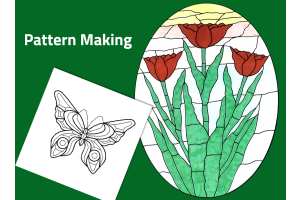We use cookies to make your experience better. To comply with the new e-Privacy directive, we need to ask for your consent to set the cookies. Learn more.
Stained-Glass Pattern Making

Stained-Glass Pattern Making
Stained glass artistry is a captivating craft that has stood the test of time, adorning windows, doors, and interior spaces with vibrant colors and intricate designs. At the heart of every stained-glass masterpiece lies a meticulously crafted pattern, serving as the blueprint for the final creation. Whether you're a novice enthusiast or a seasoned artisan, mastering the art of stained-glass pattern making opens up a world of creative possibilities. In this guide, we delve into the essential techniques and principles of pattern making, empowering you to design and create your own stunning stained-glass patterns.
Understanding the Basics
Before diving into the creative process, it's essential to understand the fundamental principles of stained-glass pattern making:
- Conceptualization: Begin by conceptualizing your design idea. Consider themes, motifs, and inspirations that resonate with you. Whether it's nature, geometric shapes, or abstract concepts, let your imagination roam freely.
- Composition: Think about the overall composition of your stained-glass piece. Balance elements such as color, shape, and negative space to create visual harmony. Sketching rough outlines or using digital design tools can help refine your composition.
- Scale and Proportion: Pay attention to scale and proportion to ensure that your design translates well into the final stained-glass piece. Experiment with different sizes and arrangements of elements to achieve the desired aesthetic balance.
Tools of the Trade
Here are some tools you can use to embark on your stained-glass pattern making journey:
- Graph Paper: Graph paper provides a structured grid that helps maintain symmetry and precision in your designs.
- Pencils and Erasers: Use pencils of varying hardness to sketch your designs on the graph paper. Erasers allow you to make corrections and adjustments as needed.
- Rulers and Compasses: Rulers and compasses are invaluable tools for creating straight lines, arcs, and circles with accuracy and consistency.
- Tracing Paper: Tracing paper allows you to experiment with different design elements and overlays without altering the original sketch.
- Digital Art: Some people choose to skip the traditional drawing tools and opt for a digital art route such as drawing on a tablet or computer.
- Reference Materials: Draw inspiration from existing stained-glass patterns, architectural motifs, and artistic styles to inform and enrich your design process.
The Creative Process
Now, let's explore the step-by-step process of creating your own stained-glass patterns:
- Research and Inspiration: Begin by gathering inspiration from various sources, such as nature, art history, and cultural motifs. Study the work of renowned stained-glass artists and explore different design styles and techniques.
- Sketching: Using your digital art tool or graph paper as your canvas, sketch out rough outlines of your design ideas. Experiment with different shapes, lines, and motifs to develop a cohesive and visually engaging composition.
- Refinement and Iteration: Refine your initial sketches through multiple iterations, focusing on clarity, balance, and visual impact. Pay attention to details such as line thickness, spacing between elements, and overall symmetry. Keep in mind how big or small you want your individual glass pieces to be and what you are comfortable with.
- Grid Method: To achieve precision and symmetry in your designs, consider using the grid method. Divide your graph paper into equally spaced squares and transfer your sketch onto the grid, square by square, ensuring accuracy and proportionality.
- Color Rendering: Once you're satisfied with the structure of your design, explore different color combinations and palettes to bring your pattern to life. This will help you pick out your glass. You can use colored pencils or markers to add shading and depth to your sketches, experimenting with light and shadow effects.
- Finalization: Review your finalized design for coherence, balance, and aesthetic appeal. Make any final adjustments or refinements to ensure that the pattern captures your artistic vision and intent.
Mastering the art of stained-glass pattern making is a journey of creativity, patience, and attention to detail. By understanding the fundamental principles of design and embracing the creative process, you can unleash your imagination and bring your unique vision to life in vibrant, luminous colors. Whether you're crafting intricate window panels, decorative ornaments, or personalized gifts, the art of stained-glass pattern making offers endless opportunities for self-expression and artistic exploration. With dedication, practice, and a spirit of curiosity, you'll unlock the transformative power of stained glass and create timeless works of art that inspire and delight for generations to come.










